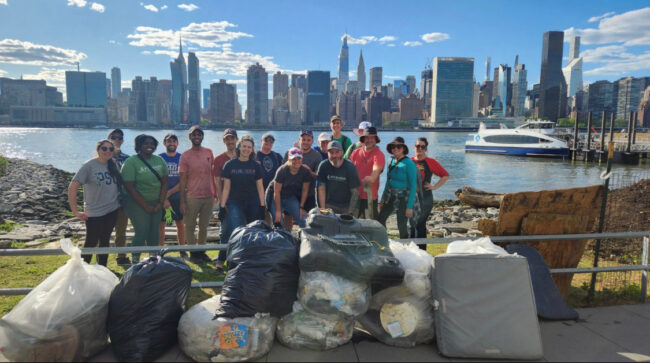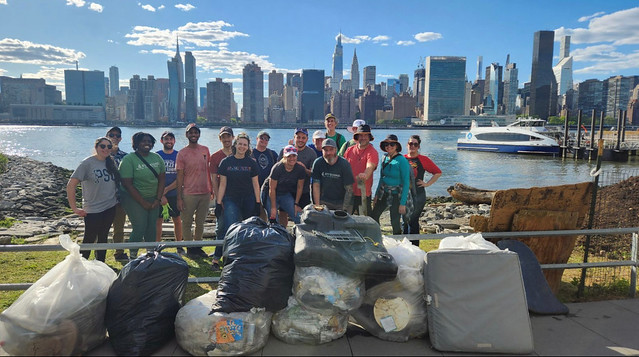12th Annual Riverkeeper Sweep: Incredible results from our May 6 day of service

View more images on our Flickr site
31 tons of debris cleaned from hundreds of miles of shoreline in NYC and the Hudson Valley.
During the 12th Annual Riverkeeper Sweep on May 6, more than 2,500 volunteers participated in the Hudson River’s largest annual shoreline cleanup. Together, in just one day, we achieved incredible results:
- 279 tires removed
- 959 native trees, shrubs, and flowers planted or maintained
- 2,514 volunteers
- 125 projects
- 31 tons of debris cleaned up
The 31-ton grand total includes 1,600 bags of trash, over 2 tons of recycling, and almost 3 tons of tires, as well as other large debris including construction materials, scrap metal, car and boat parts, Styrofoam blocks, a full sofa, shopping carts, fuel containers, a bed frame, a mattress, chairs, and inoperable vehicles.
Take a look at some highlights from along the river in this photo album:

This effort is made possible by our Sweep Leaders, volunteers, sponsors, and brewery and community partners involved in this year’s Sweep. It’s inspiring to see community organizations, schools, scout troops, religious communities and others team up to achieve visible, lasting results.
The amount of trash we find at the shorelines is certainly formidable. Happily, though, many of our Sweep project leaders are reporting that the amounts have gradually decreased over the years. It seems that the annual cleanups are having a cumulative effect on the amount of trash in and around the river – and that the care and attention shown by local volunteers is leading to better efforts to minimize litter.
What’s in Hudson River trash?
Single-use plastics, including food packaging and bottles, make up the bulk of the trash at Sweep projects. We’ve managed to pass legislation to help reduce the volume of single-use items in the environment, such as the 2015 Federal Microbeads Free Waters Act, the 2019 New York State Bag Waste Reduction Law, and the 2019 New York City bill to restrictions on the sale or use of certain expanded polystyrene items. But clearly, we have more to do.
This year, we asked volunteers to estimate the percentage of plastics by collected amount and note any product brands during their cleanups. We will continue to assess these two features in our upcoming Sweeps for any patterns we may find, including how frequent and common plastics and certain brands are in cleanups. On average, the estimated percentage of plastics collected that 54 sites were able to report on was 54 percent. The most common product brand found was Coca-Cola, followed by Budweiser, Gatorade, Poland Spring, and Corona. A larger breakdown of the brands found is in the pie chart below.
In 2023, plastic bottles remained the most common type of trash found at the project locations. Other common items include other types of beverage containers, Styrofoam, cigarette butts, small scraps of plastic, and plastic wrappers.
The trash cleanups always turn up surprises. This year we found an old cell phone, an iPad, a horror movie Halloween mask (Jason!), an inflatable unicorn, an RCA cassette tape player, bags of water-logged drugs, a Swiss watch, a moped, four e-bikes, a $10 bill, a dinner plate that says “He is no good for you,” and lawsuit paperwork in a bottle.
What we’ve achieved in a decade
Volunteers may gather debris by land, or by water – often using kayaks and small craft – plant trees, remove invasive species, or restore street ends of urban waterways. Over the course of twelve years, the Riverkeeper Sweep has involved 1,199 projects, and over 21,900 volunteers who have removed 355 tons of debris, including 35 tons of recycling and 2,089 tires. Volunteers have also planted or maintained over 7,130 native trees, shrubs, and flowers, and removed thousands of pounds of invasive species. This year the event stretched hundreds of miles of shoreline from Staten Island to the Adirondack Mountains – an incredible scale of effort happening in just one day.
With many locations becoming cleaner over time, a number of Sweep projects have shifted from cleanups to other forms of restoration, such as the removal of invasive plants. By developing partnerships in new communities, the effort continues to grow. We aim to engage as many people in the watershed as possible to help clean and restore our river and make Sweep become the largest day of river stewardship in the nation.
Comprehensive Data Collection Initiative
Sweep’s Comprehensive Data Collection Initiative was back in full swing this year. Here’s what volunteers at 9 sites found!
Globally, 11 million metric tons of plastics enter the world’s oceans every year. It’s no surprise, just think about the amount of plastic waste you spot in just a day. Litter like bags, bottles, and wrappers from across the Hudson watershed are carried by rain, rivers, and streams into the Hudson.
It’s impossible to know exactly how much and what kind of waste enters the Hudson, but looking at data collected during shoreline cleanups can give us an idea. During the 12th Annual Riverkeeper Sweep, volunteers at nine sites split into pairs to carefully record every piece of trash collected using a system adopted from the Ocean Conservancy. The results of Sweep’s Comprehensive Data Collection Initiative (CDCI) are compiled below.
Microplastic madness
This year cigarette butts topped the chart at CDCI sites. They might appear to be paper at first, but the average cigarette filter is made of cellulose acetate, and takes an average of 10 years to decompose. As they decay, cigarettes break down into microplastics. Micro trash was particularly prominent at CDCI sites this year, with plastic, foam, and glass pieces under 2.5 cm in diameter all within the top 10 items collected. Marine animals often mistake these small bits for food, harming the animal, and introducing the plastic into the food web. CDCI volunteers collected over 2,400 cigarette butts and small plastic pieces – a good reminder to properly dispose of trash.
Bottles, bottles everywhere
In past years, the most common item collected at CDCI sites has been plastic bottles. This year they didn’t top CDCI but their presence was undeniable. Volunteers across 125 sites collected more than 3100 plastic bottles from the Hudson and its tributaries. The yearly prevalence of single use plastic bottles highlights the need for action on this issue.
Volunteers did an amazing job removing a massive amount of bottles, but to put an end to the issue, legislation is needed. Riverkeeper is supporting the expansion of New York’s Bottle Deposit Law (aka the Bottle Bill) in Albany. The bill aims to expand the state’s bottle return program, increasing recycling rates and diverting trash away from the natural environment. Not only that, the bill will expand the liquid containers eligible for return to include wine, spirits, hard cider, and most non-carbonated beverages. Increasing the types of containers covered under New York’s bottle bill results in many more items being diverted from curbside recycling or trash cans to redemption centers where they have a higher likelihood of being properly recycled.
Increasing the deposit to 10 cents from 5 cents on all eligible containers recognizes how the cost of everything has risen in 40 years. It is well past time to increase the price of deposit. By doing so, New Yorkers will be much more likely to return these items, ensuring a higher overall recycling rate.
To help expand New York State’s bottle deposit program, please send a message to Governor Hochul and your state representatives that it’s time to stop plastic bottle pollution.
Policy works. Anecdotally, this year we saw a decline in plastic bags reported by Sweep leaders. It’s hard to link these results directly to New York’s plastic bag ban, but the correlation is strong, which is hopeful. Perhaps, the Bigger Better Bottle Bill will do for plastic bottles what the ban has done for plastic bags. In the meantime, Riverkeeper will continue organizing its Sweep, helping communities protect the river they rely on and cherish.
Sponsors:

Site Sponsors: Atlas Industries; Century Aggregates and Bonded Concrete; DeSimone Consulting Engineers; HVEA; Old Souls
